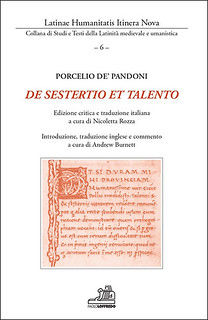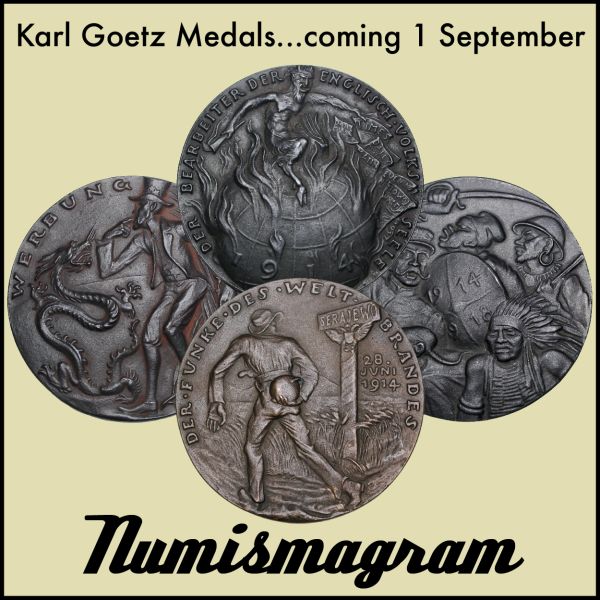
PREV ARTICLE
NEXT ARTICLE
FULL ISSUE
PREV FULL ISSUE
V25 2022 INDEX E-SYLUM ARCHIVE NEW BOOK: DE SESTERTIO ET TALENTOMitch Fraas is a senior curator for special collections at the Kislak Center for Special Collections, Rare Books and Manuscripts at the University of Pennsylvania Libraries. He passed along this new publication about one of the earliest examples of numismatic literature. Thank you! -Editor Mitch writes: "I've just gotten a copy of this first edited edition (in English and Italian) of what is claimed to be the "first treatise ever written about numismatics." One of the three known manuscript copies is in the collection which I'm responsible for here at Penn and I'm very glad to see this text getting wider circulation." DE SESTERTIO ET TALENTO - PORCELIO DE' PANDONI
Although its origins are not entirely clear, it was completed in Milan. In a prefatory letter, in fact, Pandoni offers the work to the powerful secretary of Francesco Sforza, Cicco Simonetta. In fact, as Andrew Burnett speculates, it is possible that the letter of dedication contains statements that are only partially accurate and that the treatise was originally written in Rome, the city in which Pandoni was trained and in whose cultural milieu he had had close ties to the Colonna family, and in particular to Cardinal Prospero Colonna, a well-known patron with strong interests in antiquities. If so, it was re-purposed, a typical practice of Pandoni, and, in his dedication, he placed the interest, the fascination and the antiquarian and numismatic curiosity that had brought about the writing of the short treatise, in a Milan context. A critical edition is offered here for the first time (by Nicoletta Rozza), accompanied by a full commentary (by Andrew Burnett), and with a double translation, into both Italian and English. Andrew Burnett was Deputy Director of the British Museum from 2002 to 2013, having begun his career at the Museum in 1974 in the Coins and Medals department as Research Assistant. He went on to become Deputy Keeper in 1990 and Keeper in 1992. He is a past President of the Royal Numismatic Society, the Roman Society, and of the International Numismatic Commission. His main research interests are in the coinage of Roman Britain; the early Roman coinage of the third century BC; Roman provincial coinage; and the history of Numismatics. Nicoletta Rozza got a PhD in 2016 in Filologia classica, cristiana e medioevale-umanistica, greca e latina (Classic, Christina, Medieval and Humanistic, Greek and Latin philology) at University of Naples Federico II. From 2017 she used a post-PhD research grant to study Leonardo Pisano's, also known as Fibonacci, Liber abaci, publishing in 2019 the critical edition, with italian translation and comments, of the starting epistle, of the prologus and of the first four chapters of the work. In 2019 she also won a scholarship at the Royal Numismatic Society of London. She is at the moment a researcher in Letteratura latina medievale e umanistica (Medieval and humanistic Latin literature) at University of Naples Federico II, where she makes critical and textual analysis, but also on latin scientific works and on poetry and people of Naples in XV and XVI Century. There are many firsts in numismatic literature, depending on the qualifications of the claim. While this is likely the "first treatise, there is also the "first numismatic book" (Budé's De Asse et partibus) and the "first illustrated numismatic book (Fulvio's Illustrium Imagines). I reached out to literature dealer George Kolbe and his comment is below. -Editor George writes: "It seems to me that I have seen mention of this work, attributed to Porcellius, perhaps in Clain-Stefanelli/Babelon. It is interesting that it was written about the time that Gutenberg was printing his famous bible."
For more information, or to order, see:
Wayne Homren, Editor The Numismatic Bibliomania Society is a non-profit organization promoting numismatic literature. See our web site at coinbooks.org. To submit items for publication in The E-Sylum, write to the Editor at this address: whomren@gmail.com To subscribe go to: https://my.binhost.com/lists/listinfo/esylum All Rights Reserved. NBS Home Page Contact the NBS webmaster 
|

